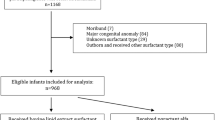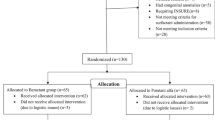Abstract
Poractant alfa (Curosurf®) is a natural, porcine-derived surfactant that is well established as an effective and generally well-tolerated agent in the treatment of respiratory distress syndrome (RDS) in preterm infants. The efficacy of poractant alfa in RDS is better than that of early-generation synthetic surfactants, and limited data are available regarding its efficacy versus new-generation synthetic agents. Poractant alfa 200 mg/kg is more effective than poractant alfa 100 mg/kg or bovine-derived beractant 100 mg/kg. Techniques for administering poractant alfa include via an endotracheal tube or less invasive techniques [e.g. less invasive surfactant administration (LISA)] performed during non-invasive ventilation of spontaneously breathing infants via nasal continuous positive airway pressure (CPAP). Administration of poractant alfa 200 mg/kg in early rescue [i.e. fraction of inspired oxygen (FiO2) ≥ 0.3] via LISA is associated with increased successful management on continuous positive airway pressure, as well as reductions in the incidence of bronchopulmonary dysplasia (BPD) and death/BPD.
Similar content being viewed by others
References
Ramanathan R. Surfactant therapy in preterm infants with respiratory distress syndrome and in near-term or term newborns with acute RDS. J Perinatol. 2006;26(Suppl 1):S51–6.
Singh N, Halliday HL, Stevens TP, et al. Comparison of animal-derived surfactants for the prevention and treatment of respiratory distress syndrome in preterm infants. Cochrane Database Syst Rev. 2015;(12):CD010249. doi:10.1002/14651858.CD010249.pub2
Ramanathan R, Rasmussen MR, Gerstmann DR, et al. A randomized, multicenter masked comparison trial of poractant alfa (Curosurf) versus beractant (Survanta) in the treatment of respiratory distress syndrome in preterm infants. Am J Perinatol. 2004;21(3):109–19.
Sweet DG, Carnielli V, Greisen G, et al. European consensus guidelines on the management of respiratory distress syndrome: 2016 update. Neonatology. 2017;111(2):107–25.
Polin RA, Carlo WA. Surfactant replacement therapy for preterm and term neonates with respiratory distress. Pediatrics. 2014;133(1):156–63.
Niemarkt HJ, Hutten MC, Kramer BW. Surfactant for respiratory distress syndrome: new ideas on a familiar drug with innovative applications. Neonatology. 2017;111(4):408–14.
WHO Model List of essential medicines: 20th list (March 2017). Geneva: World Health Organization; 2017.
Ramanathan R. Animal-derived surfactants: where are we? The evidence from randomized, controlled clinical trials. J Perinatol. 2009;29(Suppl 2):S38–43.
Zhang L, Cao H-Y, Zhao S, et al. Effect of exogenous pulmonary surfactants on mortality rate in neonatal respiratory distress syndrome: a network meta-analysis of randomized controlled trials. Pulm Pharmacol Ther. 2015;34:46–54.
Aldana-Aguirre JC, Pinto M, Featherstone RM, et al. Less invasive surfactant administration versus intubation for surfactant delivery in preterm infants with respiratory distress syndrome: a systematic review and meta-analysis. Arch Dis Child Fetal Neonatal Ed. 2017;102(1):F17–23.
Egberts J, Brand R, Walti H, et al. Mortality, severe respiratory distress syndrome, and chronic lung disease of the newborn are reduced more after prophylactic than after therapeutic administration of the surfactant Curosurf. Pediatrics. 1997;100(1):E4.
Rojas-Reyes MX, Morley CJ, Soll R. Prophylactic versus selective use of surfactant in preventing morbidity and mortality in preterm infants. Cochrane Database Syst Rev. 2012;(3):CD000510. doi: 10.1002/14651858.CD000510.pub2
Dargaville PA, Aiyappan A, De Paoli AG, et al. Continuous positive airway pressure failure in preterm infants: incidence, predictors and consequences. Neonatology. 2013;104(1):8–14.
Curosurf (poractant alfa) intratracheal suspension: UK summary of product characteristics. Manchester: Chiesi Limited; 2016.
Curosurf (poractant alfa) intratracheal suspension: US prescribing information. Cary: Chiesi USA, Inc.; 2014.
Parra E, Pérez-Gil J. Composition, structure and mechanical properties define performance of pulmonary surfactant membranes and films. Chem Phys Lipids. 2015;185:153–75.
Cogo PE, Facco M, Simonato M, et al. Dosing of porcine surfactant: effect on kinetics and gas exchange in respiratory distress syndrome. Pediatrics. 2009;124(5):e950–7.
Collaborative European Multicenter Study Group. Surfactant replacement therapy for severe neonatal respiratory distress syndrome: an international randomized clinical trial. Pediatrics. 1988;82(5):683–91.
Halliday HL, Tarnow-Mordi WO, Corcoran JD, et al. Multicentre randomised trial comparing high and low dose surfactant regimens for the treatment of respiratory distress syndrome (the Curosurf 4 trial). Arch Dis Child. 1993;69(3 Spec No):276–80.
Speer CP, Robertson B, Curstedt T, et al. Randomized European multicenter trial of surfactant replacement therapy for severe neonatal respiratory distress syndrome: single versus multiple doses of Curosurf. Pediatrics. 1992;89(1):13–20.
Dizdar EA, Sari FN, Aydemir C, et al. A randomized, controlled trial of poractant alfa versus beractant in the treatment of preterm infants with respiratory distress syndrome. Am J Perinatol. 2012;29(2):95–100.
Gharehbaghi MM, Sakha SH, Ghojazadeh M, et al. Complications among premature neonates treated with beractant and poractant alfa. Indian J Pediatr. 2010;77(7):751–4.
Singh N, Hawley KL, Viswanathan K. Efficacy of porcine versus bovine surfactants for preterm newborns with respiratory distress syndrome: systematic review and meta-analysis. Pediatrics. 2011;128(6):e1588–95.
Gopel W, Kribs A, Ziegler A, et al. Avoidance of mechanical ventilation by surfactant treatment of spontaneously breathing preterm infants (AMV): an open-label, randomised, controlled trial. Lancet. 2011;378(9803):1627–34.
Kanmaz HG, Erdeve O, Canpolat FE, et al. Surfactant administration via thin catheter during spontaneous breathing: randomized controlled trial. Pediatrics. 2013;131(2):e502–9.
Kribs A, Roll C, Gopel W, et al. Nonintubated surfactant application vs conventional therapy in extremely preterm infants: a randomized clinical trial. JAMA Pediatr. 2015;169(8):723–30.
Mirnia K, Heidarzadeh M, Hoseini MB, et al. Comparison outcome of surfactant administration via tracheal catheterization during spontaneous breathing with INSURE. Med J Islam World Acad Sci. 2013;21(4):143–8.
Rigo V, Lefebvre C, Broux I. Surfactant instillation in spontaneously breathing preterm infants: a systematic review and meta-analysis. Eur J Pediatr. 2016;175(12):1933–42.
Wu W, Shi Y, Li F, et al. Surfactant administration via a thin endotracheal catheter during spontaneous breathing in preterm infants. Pediatr Pulmonol. 2017;52(6):844–54.
Robertson B, Curstedt T, Tubman R, et al. A 2-year follow up of babies enrolled in a European multicentre trial of porcine surfactant replacement for severe neonatal respiratory distress syndrome. Eur J Pediatr. 1992;151(5):372–6.
Sweet DG, Turner MA, Straňák Z, et al. A first-in-human clinical study of a new SP-B and Sp-C enriched synthetic surfactant (CHF5633) in preterm babies with respiratory distress syndrome. Arch Dis Child Fetal Neonatal Ed. (E-pub 2017). doi:10.1136/archdischild-2017-312722.
Jobe AH. Mechanisms to explain surfactant responses. Biol Neonate. 2006;89(4):298–302.
Fujii AM, Bailey J, Doros G, et al. Effects of beractant and poractant administration on cerebral hemodynamics. J Neonatal Perinat Med. 2009;7(2):27–34.
Sandri F, Plavka R, Ancora G, et al. Prophylactic or early selective surfactant combined with nCPAP in very preterm infants. Pediatrics. 2010;125(6):e1402–9.
Klotz D, Porcaro U, Fleck T, et al. European perspective on less invasive surfactant administration: a survey. Eur J Pediatr. 2017;176(2):147–54.
Kribs A. Minimally invasive surfactant therapy and noninvasive respiratory support. Clin Perinatol. 2016;43(4):755–71.
Dargaville PA, Gerber A, Johansson S, et al. Incidence and outcome of CPAP failure in preterm infants. Pediatrics. 2016;138(1). doi:10.1542/peds.2015-3985.
Fuchs H, Lindner W, Leiprecht A, et al. Predictors of early nasal CPAP failure and effects of various intubation criteria on the rate of mechanical ventilation in preterm infants of <29 weeks gestational age. Arch Dis Child Fetal Neonatal Ed. 2011;96(5):F343–7.
De Jaegere AP, van der Lee JH, Canté C, et al. Early prediction of nasal continuous positive airway pressure failure in preterm infants less than 30 weeks gestation. Acta Paediatr. 2012;101(4):374–9.
Rocha G, Flôr-de-Lima F, Proença E, et al. Failure of early nasal continuous positive airway pressure in preterm infants of 26 to 30 weeks gestation. J Perinatol. 2013;33(4):297–301.
Acknowledgements
The article was reviewed by: A. A. Fujii, Department of Pediatrics, Boston Medical Centre, Boston MA, USA; R. Ramanathan, Division of Neonatal Medicine, Department of Pediatrics, LAC+USC Medical Center, Keck School of Medicine, University of Southern California, Los Angeles, CA, USA. During the peer review process, the marketing authorization holder of poractant alfa was also offered an opportunity to review this article. Changes resulting from comments received were made on the basis of scientific and editorial merit.
Author information
Authors and Affiliations
Corresponding author
Ethics declarations
Funding
The preparation of this review was not supported by any external funding.
Conflict of interest
K. McKeage and K. A. Lyseng-Williamson are employees of Adis/Springer, are responsible for the article content and declare no conflicts of interest. Additional information about this Adis Drug Review can be found at http://www.medengine.com/Redeem/AFD8F060014061F3.
Rights and permissions
About this article
Cite this article
McKeage, K., Lyseng-Williamson, K.A. Poractant alfa in respiratory distress syndrome in preterm infants: a profile of its use. Drugs Ther Perspect 33, 455–462 (2017). https://doi.org/10.1007/s40267-017-0437-3
Published:
Issue Date:
DOI: https://doi.org/10.1007/s40267-017-0437-3




